#The Super Robot segment is definitely going to be the weakest part
Explore tagged Tumblr posts
Text
Armored Core, Video Games, Mecha: A Cultural Study of A Genre.
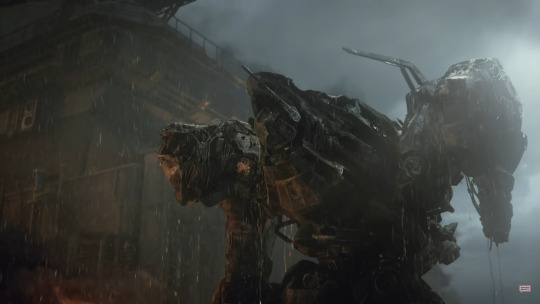
In 1997, From Software (フロム・ソフトウェア) released "Armored Core" (アーマード・コア) for the Sony PlayStation. While definitely not the first "Mecha Game" as we'll be referring to ad nauseam in this bizarre, overly long, essay thing of sorts- it more than the rest is arguable the most important. Through its mechanics, story, gameplay, and even setting- everything about Armored Core reinforces that it is the first Mecha IP made for the brand new at the time "video game medium" that fully embodied everything that defines the cultural and historical influences of the modern Mecha Genre, while redefining that genre for the newer medium. To this day, with the most recent release of "Armored Core VI: The Fires of Rubicon" in August of 2023, the series continues to uphold and redefine this legacy. Yet, what does any of that even mean?
To make a long story shortened, somewhat long once again; as we know it outside of Japan "Mecha", is a niche of a niche in some cases. Not necessarily that it's unpopular, or doesn't make an insane amount of money (which it is and does in both cases quite often), but in that it is a genre almost entirely defined by its roots in Japan, primarily through various Manga Comics and especially Animated Series. Go Nagai's (永井 豪) "Mazinger Z" (1972) is credited most often as the birth of the genre's identity, most notably as the first real breakout attempt at conceptualizing the idea of a large robot that was controlled through the use of a cockpit within the robot itself. In Go Nagai's words within the book "A Brief History of Japanese Robophilia"; "I wanted to create something different, and I thought it would be interesting to have a robot that you could drive, like a car."
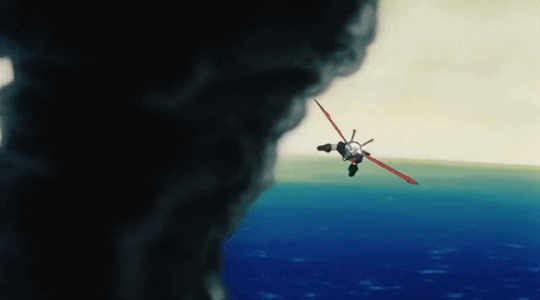
From this idea and the incredible popularity of Mazinger Z, "Robot Anime" (ロボットアニメ) was born, and Go Nagai went on to create more influential works that helped further expand the genre as well as develop this particular flavor as "Super Robot". Now, Super Robot being the first and oldest sub-category to the genre makes what came after works like the aforementioned Mazinger Z and later "Getter Robo" (also from Go Nagai, 1974) fascinating from an outsider to the culture and times of the late 20th Century Japan. Without going too much into a side tangent, shows like Mazinger Z and Getter Robo were the foundation of which everything that would come to pass was built on. Discussing Mazinger Z and Getter Robo with friends and people who love it, however, the one thing that was constantly said was that "They still were and are, monster of the week animated shows", the Super Robots being genuinely not too dissimilar to how super heroes or super powered characters in other cartoons or comics were depicted other than they were both vehicle and the powers themselves. They are still shows about cool/surprising fights with evil monsters or wicked folk- and that's what they really want to be.
Not to say there's little under the surface (I would never dare to even humor a claim like that in regards to near any media), but for example- Getter Robo, which introduced the concept of "gattai" (合体), better known as "combination", where these super robots or aspects of them could "combine together" to create a bigger, stronger, or better robot- combined with the introduction of the show's "Getter Rays", the primary antagonists being what are genuinely, dinosaur aliens, Getter Robo has a very clear and distinct theme of "Evolution" that permeates through its entire core- but its also secondary to the actual point of the series from what I've been informed. To quote directly from a friend who's a massive fan and shill for the series: "This is the invention of the wheel, no one has thought to put trims on it," which is not a criticism at all- but I think it's important to especially point that out here and now that this is what the Super Robot era of early Mecha was, really cool and fun ideas for media that wanted to be surprising, fun, and fresh for the early 1970s.
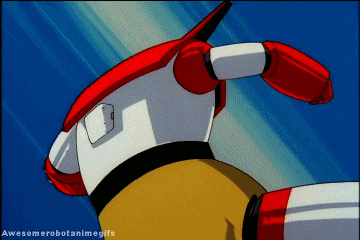
The other thing that was most interesting about the era of Super Robot, was that despite robots- the powers and abilities explored in these series were supernatural or magical in nature; Getter Rays for example is quite literally, human will made manifest- allowing their machines to fire beams of energy, transform their parts, amongst several other things. Some would say it's "on the nose", but frankly it's inspired and has persisted as an idea all the way to present in even modern Mecha that isn't Super Robot.
But then, what did come after the Super Robot era of early Mecha? When a genre has only escalated and expanded, going further into the fantastical and erratic energy of its fore-bearers and contemporaries; bigger, brighter, louder- where do we look once we've waged battle with every single light in the sky? When there's no battles left to be fought with aliens, kaiju, or other such monsters that threaten to snuff out our spark, try to tango with the human spirit and its indomitable will- eventually our sights go from the stars above, back to where all battles and conflict are directed at.
Each other.

(this post is continued in a series of reblogs, be sure to check them out!)
#mecha#mech#mechs#japan#culture study#essay#writing#armored core#ac#日本#ロボット#レアルロボット#メカ#armored core 6#personal essay#mobile suit gundam#gundam#スパーロボット#Whoof I'm really nervous about this I'll be honest#The Super Robot segment is definitely going to be the weakest part#As admittedly it's the one I'm least informed on#I'm eternally grateful for my friends that are into the roots of the genre#I'm also very open to constructive criticism#this post might be stuck in eternal edit checks but HEY I POSTED IT#which is more than I thought I would#woof wow okay right#thank you everyone#Will see how this pans out#I think the first update will just be linking my sources should tumblr allow me to add anymore to this wall of text and funny gifs#now I'm just yapping
26 notes
·
View notes
Text
Robot Carnival Review
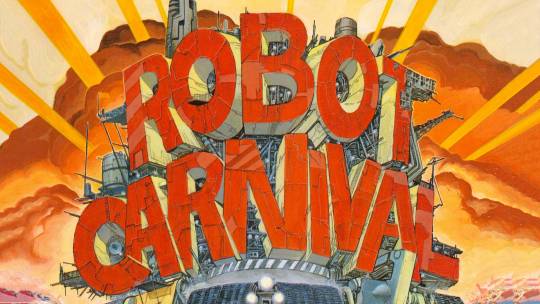
When I first started my blu-ray collecting kick, Discotek was hyping up their release of Memories, an anthology movie organized by Akira’s Katsuhiro Otomo. While doing research on it, I saw it was recommended in the company of Robot Carnival, another anthology movie Otomo was involved with, with more animators and thus individual shorts, and a unifying theme of “robots”. As a robot enjoyer, I figured I couldn’t go wrong with this, and I was right! This was a joy from start to finish, where even the weakest segment still had plenty to offer. If this sounds like it might be up your alley, it’s available to stream for free on RetroCrush and YouTube!
Additional note before I get into talking about each short individually: with the exception of Cloud, the music for every short was composed by Joe Hisaishi, who has way more range as a composer than I would’ve ever expected, considering I knew him exclusively as the Studio Ghibli composer. Additional additional note: I watched the anthology in the original Japanese order, the version on RetroCrush and YouTube uses an alternate order from the international release.
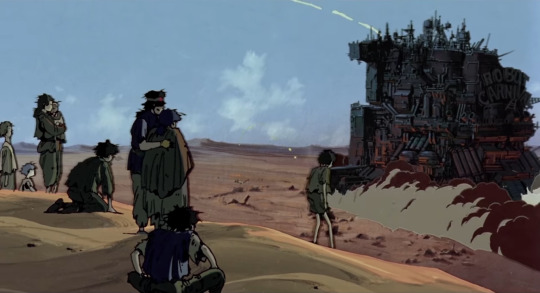
Opening/Ending (Katsuhiro Otomo, creator of Akira and Atsuko Fukushima, key animator on dozens of anime projects, including Akira) - A mobile fortress (literally the above Robot Carnival logo) traverses a post-apocalyptic wasteland, bringing death and destruction wherever it goes. The Opening sets the bar for what you should expect going forward in terms of production values, and the Ending is a nice send off for the whole thing, but I don’t really have much else to say about these shorts.
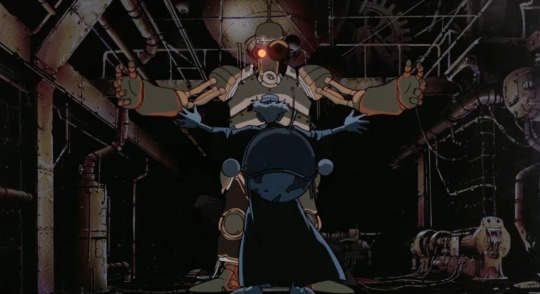
Franken’s Gears (Koji Morimoto, Director of Memories: Magnetic Rose) - A mad scientist attempts to bring their robot to life, succeeds horribly. I think of all the shorts in this movie, this one has the most impressive mechanical animation. The whole thing takes places in the scientist’s lab, and the emphasis really is on all of the ways the environment is struggling to bring the robot to life, to the point that once it does so, it begins to crumble and break apart. But the animation on the scientist himself is also really charming; the way he moves almost makes him look gooey, which is apt because my sister pointed out he was probably designed after a snail, what with the big orb on his back.
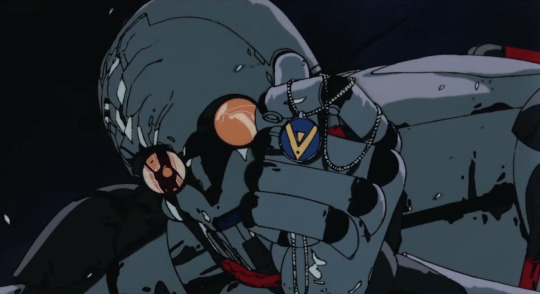
Deprive (Hidetoshi Omori, Animation Director for Char’s Counterattack) - A super android has to mamoru his imouto from an invading alien robot army. One of my favorite shorts in the anthology, this was an entire action movie expertly condensed down into not even ten minutes, complete with an awesome soundtrack. I’d actually go so far as to call this one perfect for what it is, but it’s not much more than that.
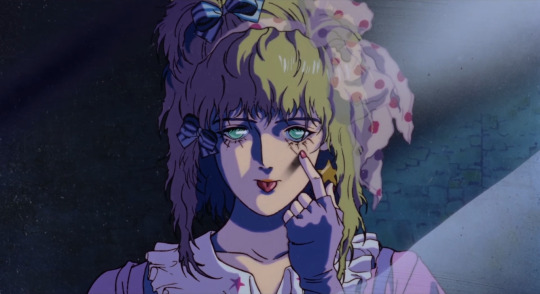
Presence (Yasuyomi Umetsu, Character Designer and Chief Animation Director of Megazone 23 Part II) - A man builds an android for companionship, and he gets more than he bargained for. Longest piece in the compilation by a mile, and the first one with voice acting. Despite enjoying some of the other shorts more, I think I would call Presence the “centerpiece” of this anthology, as it’s definitely the most story-rich. It even has some prescient worldbuilding: the people of this setting do not see robots as sentient beings, which is shown right at the start when a bunch of kids knock the head off of an android and play with it while absolutely no one in the crowded plaza reacts. This sets the tone for the main character’s interactions with his creation, and provide additional context for the things he does besides the obvious explanations.
This was also the first short where I noticed something off about the animation, where it seemed to animate too well in for certain movements. As it turns out I was right; the liner notes explain that the director was using this project to experiment, and he would animate different movements on different frame counts. It’s not terrible, but it is a little distracting to see how smoothly something like a simple head turn will animate while more complex motions look more standard. Also, unrelated but fun coincidence: the liner notes also explain a reference in the script to a story called Daddy Long Legs, about an orphan girl who receives funding from a wealthy philanthropist she never meets, which explains a reference that went over my head Yakuza: Like a Dragon.
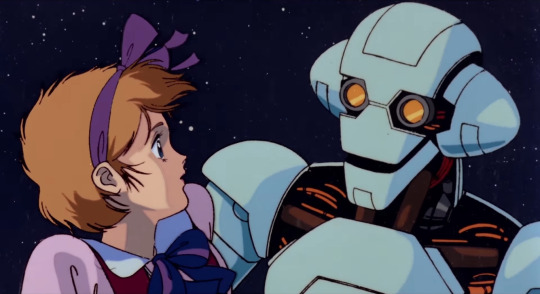
Star Light Angel (Hiroyuki Kitazume, Character Designer and Animation Director for Mobile Suit Gundam ZZ and Char’s Counterattack) - What could have been the most effective piece of robosexual propaganda ever made: a girl and her friend are at Tokyo Disneyland ROBOT WANDERLAND and are having a wonderful time, until she discovers that her boyfriend is cheating on her, at which point she retreat into the park and winds up on a virtual reality ride. Meanwhile, a robot performer attempts to find her and return the locket she dropped while she ran past him. This is tied for my favorite, alongside Deprive, because I’m a big sucker for romance and the main song for the short is so perfect for the content. I was also delighted to find the explanation for this short was that Kitazume, who’s work up to this point was all mecha anime like Aura Battler Dunbine and Zeta Gundam, really wanted to try to flex with character expressions, and it came through brilliantly as the range and level of facial expressions was the first thing I really took notice of in this. Funny enough, though, Kitazume also apparently said he considers this and Deprive to be the weakest pieces of the anthology, and I suppose he’s right in that they have the least meat on their bones and are also probably the least technically impressive, but still: my two favorites!
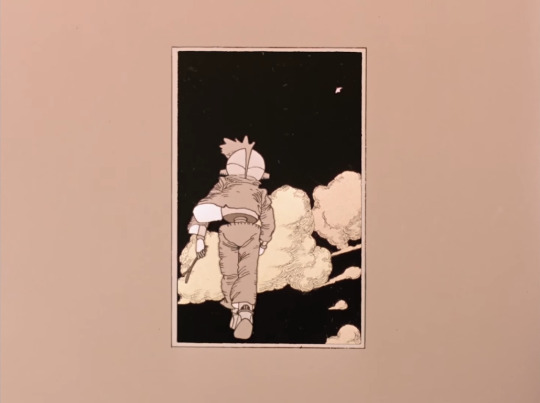
Cloud (Mao Lamdo, a prolific animator on many projects, but probably best known for this) - A robotic boy wanders past a series of ever-changing clouds. Cloud is definitely a stand-out short for a number of reasons, from the way its animated to the incredibly tangential connection to the “robot” theme, and to be perfectly honest I got a lot more out of it after I read the liner notes. The short was adapted from a self-published book Mao Lamdo had written years prior that had nothing to do with robots, and his interpretation of the short and the change to making the main character a robot was that it represented his frustration with the trend in the anime industry at the time trending towards a being obsessed with the mechanical world, while he still preferred to draw and animate nature. As I mentioned at the top, this is also the only short to not have music composed by Joe Hisaishi, instead the piece used is by Isaku Fujita, and as far as I can tell, this is his only credit. Still, it’s a good credit to have; Lamdo said the song evoked the idea of having a conversation with God and asking the big questions, which I can completely see.
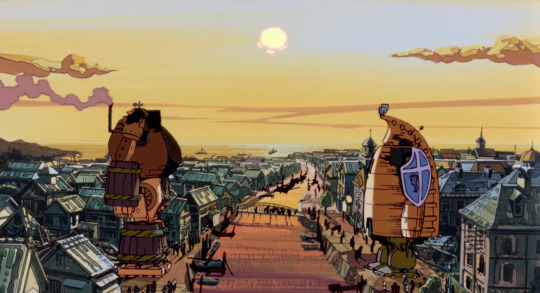
Strange Tales of Meiji Machine Culture: “The Westerner’s Invasion” (Hiroyuki Kitakubo, Director of the JoJo’s Bizarre Adventure OVA and Golden Boy) A terrible steampunk mech invades a Japanese town, and is warded off by a team of youths piloting their own terrible steampunk mech. I watched this one with the English dub first and then again in Japanese because it’s been a fuckin’ minute since I heard a dub this racist, complete with changing r’s to l’s and vice versa, only to be cracked across the skull by what I am certain was a Japanese man doing his very best to phonetically read English in the Japanese version. In spite of that, though, this is easily the funniest short for all the right reasons, and it kinda clicked once I found out that the director was also responsible for Golden Boy; it’s that exact kind of humor, complete with a protagonist who could very well be Kintaro Ue’s ancestor.
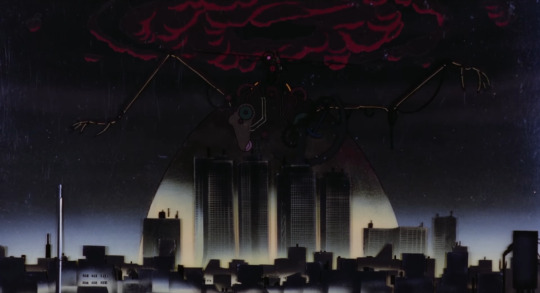
Chicken Man and Red Neck, a.k.a. Nightmare (Takeshi Nakamura, director of Catnapped! The Movie) - A robotic magician wreaks havoc on a city by transforming everything in sight into robotic monsters, and a vagrant gets caught up in the chaos. I initially wrote down “this one has the energy of a Don Bluth movie, particularly In the Dark of the Night from Anastasia”, although the liner notes say he actually was inspired by Night on Bald Mountain, which is definitely a more flattering inspiration and more accurate, to boot. I think of all the shorts in this anthology, this one gets the prizes for “best overall animation” and “best use of robots”, and it also has the most intense PS1 RPG sounding music, which once again speaks to Joe Hisaishi’s talent as a composer for doing that a full decade before the PS1 even existed. Also, fun trivia, the director turned down an offer from Hayao Miyazaki to be animation director on Castle in the Sky to make this, which… was maybe not the best career move, but still this was a terrific short and I’m glad to have it.
Again, the movie is easily accessible for free streaming, and I’d heartily recommend you check it out if you haven’t already. But if you’re into collecting physical media, the blu-ray is crammed full of tons of goodies, including the liner notes I’ve referenced, art galleries for each segment, and a lot of other production materials. Discotek also announced they’re doing a 4k UHD release of this soon, which won’t include all the extras due to the way UHD discs work, but I gotta be honest, this would be worth double dipping for if the resolution bump is noticeable enough.
5 notes
·
View notes